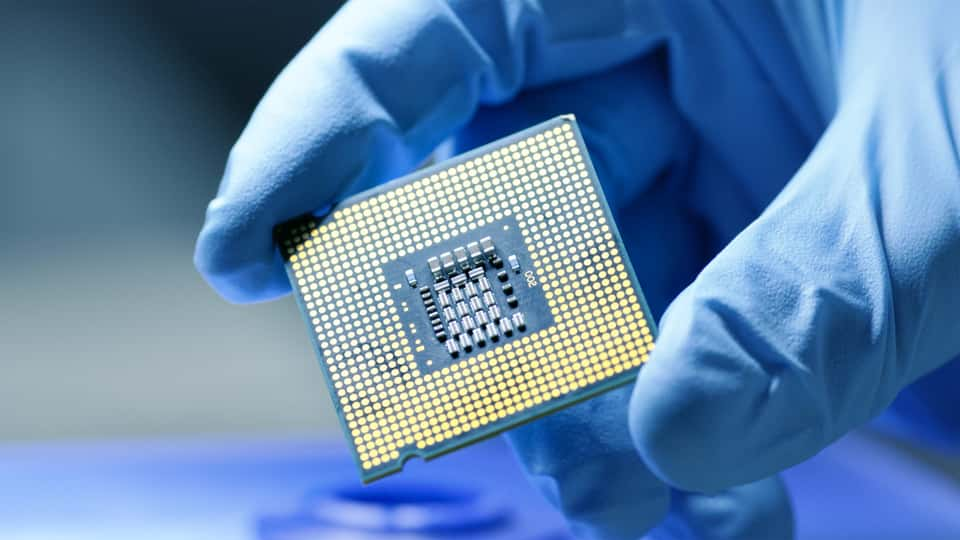The global semiconductor industry witnessed a 24% year-over-year sales growth in October 2021. However, given the continuing chip shortage, governments and corporations are making considerable efforts to increase funds and provide incentives to help companies ramp up chip production and address the ongoing supply-demand shortage. As a result, the global semiconductor shortage is expected to ease by the end of 2022.
Moreover, innovation in the chipmaking process and manufacturing of advanced chips should foster the industry’s growth. Growing investor optimism in this space is evident in the SPDR S&P Semiconductor ETF’s (XSD) 1.2% gains over the past month, versus the SPDR S&P 500 Trust ETF’s (SPY) negative returns. The global semiconductor market is expected to grow at a 7.7% CAGR to $778 billion by 2026. As a result, fundamentally-sound large-cap stocks Taiwan Semiconductor Manufacturing Company Limited (TSM) and Applied Materials, Inc. (AMAT) should benefit substantially.
However, given the current challenges faced by the industry and ongoing market volatility, overvalued stocks in this space, NVIDIA Corporation (NVDA) and Advanced Micro Devices, Inc. (AMD), will likely remain under pressure in the near term.
Stocks to Buy:
Taiwan Semiconductor Manufacturing Company Limited (TSM)
With a $619.74 billion market cap, TSM is a Taiwan-based company that manufactures, sells, and packages integrated circuits and other semiconductor devices and provides computer-aided design services. The company provides wafer manufacturing, probing, assembly, testing, mask production, and design services. It serves customers in the computer, communications, consumer, and industrial and standard segments worldwide.
On November 22, 2021, TSM and MediaTek, a Taiwanese fabless semiconductor company, unveiled the MediaTek Pentonic 2000 ─ the world’s first 7-nanometer 8K digital TV flagship SoC. Built with TSM’s N7 advanced process technology, this chip incorporates the most powerful CPU and GPU combination in the TV industry, with ultra-wide memory and fast UFS storage, powerful AI engines, Motion Estimation and Motion Compensation (MEMC), Versatile Video Coding (VVC) decoding and picture-in-picture technology. Delivering unparalleled performance and power efficiency, the companies expect to witness great demand for this chip to power next-generation flagship 8K TVs.
TSM’s net revenue for its fiscal third quarter, ended September 30, 2021, increased 16.3% year-over-year to $14.88 billion. The company’s gross profit came in at $7.63 billion, up 11.7% from the prior-year period. Its income from operations increased 14% year-over-year to $6.14 billion. While its net income increased 13.9% year-over-year to $5.61 billion, its earnings per ADR increased 13.8% to $1.08. As of September 30, 2021, the company had $30.64 billion in cash and cash equivalents.
Analysts expect TSM’s EPS to improve 21.2% year-over-year in the current year to $4.11. It surpassed consensus EPS estimates in each of the trailing four quarters. The consensus revenue estimate of $56.88 billion for the current year represents a 25% rise year-over-year. Analysts expect the stock’s EPS to rise at a 15.8% rate per annum over the next five years.
The stock has gained 14.4% over the past year and 2% over the past six months. It ended yesterday’s trading session at $119.50. In terms of forward EV/EBITDA, TSM is currently trading at 14.39x, which is 12.9% lower than the 16.52x industry average. In terms of forward Price/Cash Flow, TSM is currently trading at 16.39x, which is 29.7% lower than the 23.32x industry average.
TSM’s POWR Ratings reflect this promising outlook. The stock has an overall B rating, which equates to Buy in our proprietary rating system. The POWR Ratings are calculated by considering 118 distinct factors, with each factor weighted to an optimal degree.
The stock has an A grade for Momentum and Quality, and a B grade for Sentiment and Stability. Click here to see additional TSM’s ratings for Quality and Value.
Of the 100 stocks in the A-rated Semiconductor & Wireless Chip industry, TSM is ranked #48.
Applied Materials, Inc. (AMAT)
AMAT provides material engineering solutions for making semiconductor chips to electronic manufacturers of flat panel displays, solar photovoltaic cells, and modules. The company also supplies equipment to produce coatings for flexible electronics, packaging, and other applications. It has a market capitalization of $137.83 billion.
On October 18, 2021, AMAT unveiled a unique eBeam metrology system that facilitates a new playbook for patterning control based on massive on-device, across-wafer, and through-layer measurements. This breakthrough in metrology enables the best performance, power, area cost, and time to market, and the company expects it to witness widespread recognition across the industry in the near term.
For its fiscal fourth quarter, ended October 31, 2021, AMAT’s net sales increased 37.6% year-over-year to $3.95 billion. The company’s adjusted gross profit came in at $2.95 billion, indicating a 37.8% rise from the prior-year period. Its adjusted operating income came in at $2.03 billion, representing a 53.1% year-over-year improvement. Its adjusted net income came in at $18.53 billion, up 53% from the prior-year period. Its adjusted EPS increased 55.2% year-over-year to $1.94. As of October 31, 2021, the company had $5 billion in cash and cash equivalents.
Analysts expect the stock’s EPS to grow 19% year-over-year to $8.14 in the current year. The consensus revenue estimate of $26.37 billion for the current year represents a 14.4% rise from the prior-year period. It surpassed Street EPS estimates in three of the trailing four quarters. Analysts expect the stock’s EPS to grow at a rate of 16.5% per annum over the next five years.
The stock has gained 73.8% over the past year and 13.4% over the past six months. It closed yesterday’s trading session at $152.65. AMAT’s 15.96x forward EV/EBITDA is 3.4% lower than the 16.52x industry average. And in terms of forward Price/Cash Flow, AMAT is currently trading at 18.20x, which is 21.9% lower than the 23.32x industry average.
AMAT’s strong fundamentals are reflected in its POWR Ratings. The stock has an overall rating of B, which equates to Buy in our proprietary rating system.
The stock has an A grade for Momentum, and a B grade for Quality. Click here to see the additional ratings for AMAT (Growth, Value, Stability, and Sentiment).
AMAT is ranked #53 in the same industry.
Stocks to Avoid:
NVIDIA Corporation (NVDA)
With a market capitalization of $759.81 billion, NVDA designs and manufactures computer graphics processors, chipsets, and related multimedia software used in the gaming, professional visualization, data center, and automotive markets. Its products are sold to OEMs, ODMs, system builders, add-in board manufacturers, retailers/distributors, Internet and cloud service providers, mapping companies, and other ecosystem participants.
On November 9, 2021, NVDA released the NVIDIA Omniverse Replicator, a powerful synthetic-data-generation engine that produces physically simulated synthetic data for training deep neural networks. It introduced two applications for generating synthetic data for hosting the digital twin of autonomous vehicles and manipulation robots. Expected to launch next year, NVDA is looking forward to helping developers create large and diverse physically accurate datasets to build high-quality, high-performing, and safe datasets, which is essential for AI.
As of October 31, 2021, the company had $1.29 billion in cash and cash equivalents, down 42.8% from the prior-year period. The stock has gained 135.8% over the past year but lost marginally over the past month. It closed yesterday’s trading session at $304.90.
NVDA’s 71.54x forward EV/EBITDA is 333.1% higher than the 16.52x industry average. And in terms of forward Price/Cash Flow, NVDA is currently trading at 71.08x, which is 204.8% higher than the ‘
NVDA’s weak prospects are reflected in its POWR Ratings. The stock has an overall C rating, which equates to a Neutral in our proprietary rating system.
NVDA has a D grade for Value and Stability. To see additional POWR Ratings for Growth, Sentiment, Momentum, and Quality, click here.
NVDA is ranked #65 in the same industry.
Advanced Micro Devices, Inc. (AMD)
AMD offers microprocessors, chipsets, GPUs, server and embedded processors, semi-custom System-on-Chip (SoC) products, technology for game consoles, and provides assembly, testing, and packaging services. It has a market capitalization of $166.77 billion.
On November 10, 2021, International Business Machines Corporation’s (IBM) IBM Cloud chose AMD’s 3rd Gen AMD EPYC processors to expand its bare metal service offerings that are designed to power customers’ demanding workloads and solutions. Featuring 128 cores, up to 4TB of memory, and 10 NVMe drives per server, these servers combined with AMD EPYC 7763 processors give users full access to thigh-end, dual-socket performance. AMD expects to witness high demand from hosting companies in the coming months and sustain a long-term partnership with IBM.
AMD’s revenue for the fiscal third quarter, ended September 25, 2021, increased 54% year-over-year to $4.31 billion. The company’s non-GAAP gross profit came in at $2.09 billion, representing a 69.5% year-over-year improvement. Its non-GAAP operating income came in at $1.06 billion, up 101% from the prior-year period. Its non-GAAP net income came in at $893 million for the quarter, representing a 78.2% rise from its year-ago period. And its non-GAAP EPS increased 78% year-over-year to $0.73. The company had $2.44 billion in cash and cash equivalents as of September 25, 2021.
AMD has gained 53.7% over the past year but lost 7.3% over the past month. It ended yesterday’s trading session at $138.10. AMD’s 40.81x forward EV/EBITDA is 147% higher than the 16.52x industry average. And in terms of forward Price/Cash Flow, AMD is currently trading at 46.57x, which is 99.7% higher than the industry average of 23.32x.
AMD’s POWR Ratings are consistent with this bleak outlook. AMD has a D grade for Stability. In addition to the POWR Rating grades I have highlighted, one can see AMD’s ratings for Sentiment, Growth, Value, Momentum, and Quality here.
AMD is ranked #82 in the same industry.
Want More Great Investing Ideas?
NVDA shares were trading at $301.98 per share on Friday afternoon, down $2.92 (-0.96%). Year-to-date, NVDA has gained 131.48%, versus a 27.14% rise in the benchmark S&P 500 index during the same period.
About the Author: Sweta Vijayan

Sweta is an investment analyst and journalist with a special interest in finding market inefficiencies. She’s passionate about educating investors, so that they may find success in the stock market. More...
More Resources for the Stocks in this Article
| Ticker | POWR Rating | Industry Rank | Rank in Industry |
| NVDA | Get Rating | Get Rating | Get Rating |
| AMD | Get Rating | Get Rating | Get Rating |
| AMAT | Get Rating | Get Rating | Get Rating |
| TSM | Get Rating | Get Rating | Get Rating |





